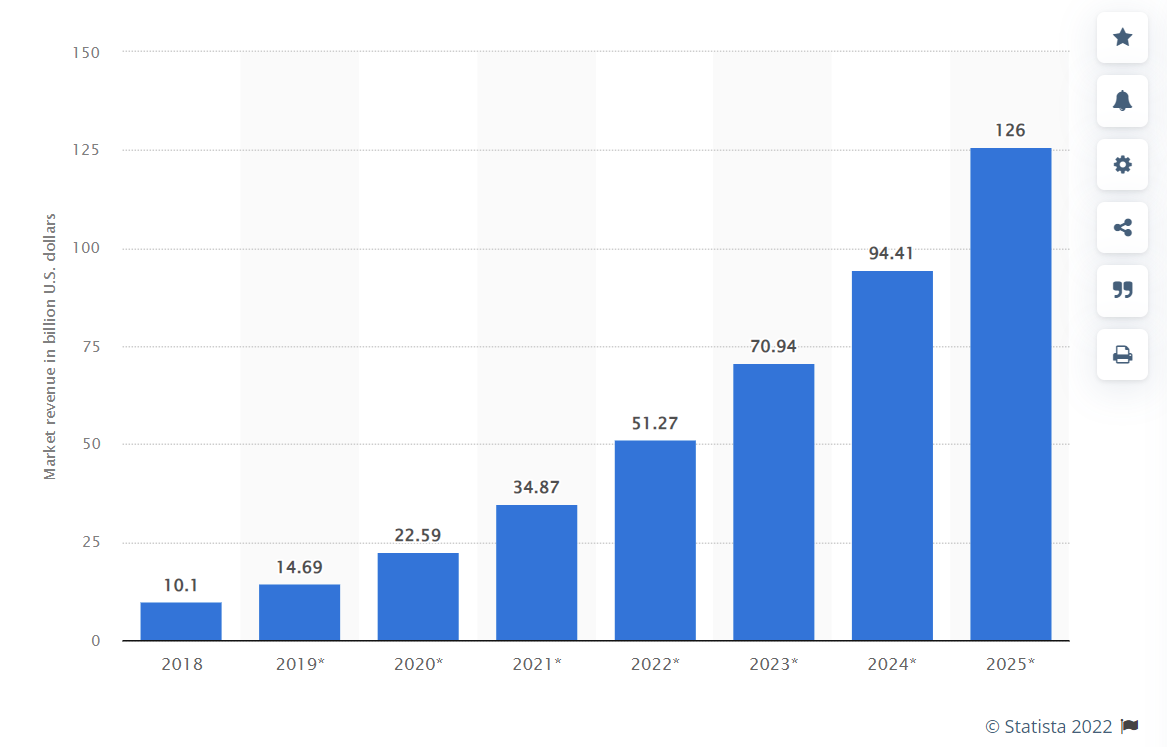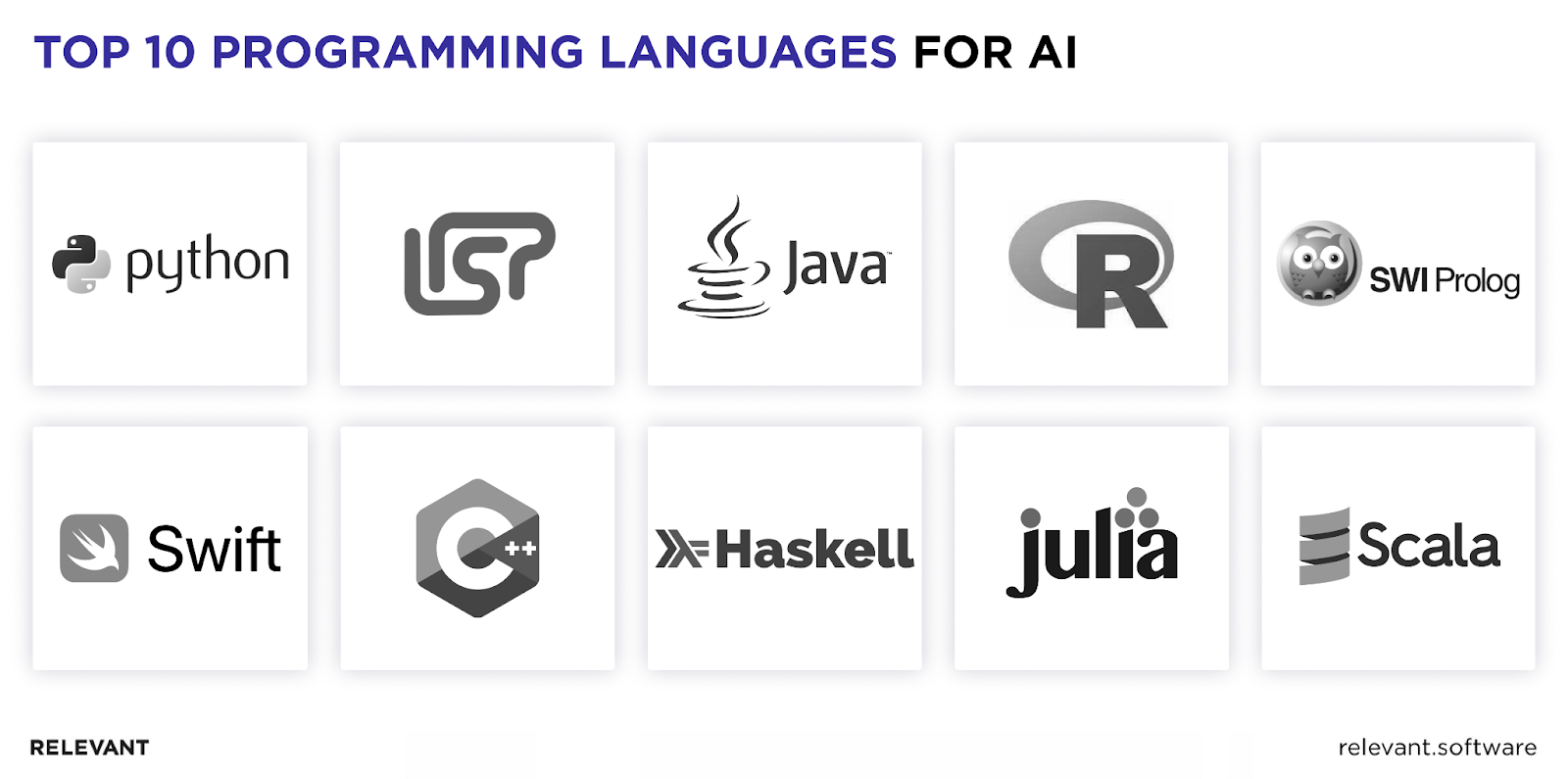Choosing the Right Language for AI: What’s Hot, What’s Not
Updated: June 4, 2025
The digital revolution that we are currently experiencing leans heavily on the shoulders of Artificial Intelligence (AI), marking a monumental shift in our lifestyle, work habits, and cognitive processes. This immense transformation is driven by the rapid strides in AI, characterized by innovative algorithms, advanced machine learning methodologies, and sophisticated natural language processing prowess.
Undeniably, AI’s explosive growth and capabilities would have remained a distant dream if not for the dynamic programming languages for AI. These languages have supported and shaped the evolution and rich variety of AI applications.

We provide companies with senior tech talent and product development expertise to build world-class software. Let's talk about how we can help you.
Contact usIn this article, we will dive deep into the characteristics and applications of programming languages for AI to equip you with the knowledge and insights for informed choices for your AI-centric project needs.
Table of Contents
What is AI, and how is it Changing Various Sectors?
Artificial Intelligence (AI) is a multifaceted subset of computer science that empowers machines with capabilities resembling human intelligence. Through intricate algorithms and neural network models, AI facilitates machines to learn from experiences, adapt to new data, and execute tasks that ordinarily necessitate human intelligence.

At the core of AI are Machine Learning (ML) and Deep Learning (DL). ML algorithms autonomously learn from data, extracting patterns and making predictions or decisions without explicit programming. DL, a subset of ML, employs artificial neural networks with multiple hidden layers, enabling machines to process data nonlinearly, improving their learning capabilities.
AI’s impact on various sectors is transformative, redefining traditional paradigms and enabling unprecedented efficiencies. Here are some examples:
- Healthcare: Embodying an invaluable aide, AI swiftly diagnoses, hones treatment plans, and individualized medicine, all while offering enhanced digital support.
- Finance: As a market forecaster, AI unravels intricate market trends, extends customized financial advice, and fortifies mechanisms against fraudulent activities.
- Manufacturing: AI is a transformative force, molding assembly lines, guarding equipment with predictive maintenance, and streamlining inventory management.
- Entertainment: AI crafts bespoke viewer experiences by suggesting content that resonates with personal tastes, helping to increase viewer engagement.
- Retail: AI carves unique customer experiences, anticipates demand fluctuations, bolsters logistics, and deploys round-the-clock chatbots for an unwavering customer service commitment.
- Transportation: AI smoothens navigation through complex environments and refines routing via sophisticated decision-making and traffic predictions.
In summary, AI’s capacity to learn, adapt, and deliver intelligent responses is driving innovative applications across various sectors. Statista anticipates the AI market soaring to an impressive $126 billion by 2025. The cornerstone applications driving this remarkable growth predominantly revolve around natural language processing, machine learning, and robotic process automation.

Top Programming Languages for AI
Are you pondering questions like, “What is the most common language used for writing artificial intelligence (AI) models?” or “Which language is AI written in?” The expansive universe of AI incorporates diverse areas, from data analysis and natural language processing to robotics, each often requiring a specific AI programming language. Let’s explore the most prominent languages for AI, their distinct features, and the advantages that make them the preferred choice for varying AI applications:

Python
Python’s reign in AI and machine learning is unwavering, endorsed by the thrice-acclaimed TIOBE index annual award. With its clear and accessible syntax, Python enables artificial intelligence programmers to concentrate on AI problem-solving, not language nuances. Notably, Python’s rich ecosystem of libraries, including TensorFlow, Keras, Nltk, and PyTorch, provides a wide array of pre-built functions and algorithms, expediting development. Its vast community support ensures continuous enhancements and access to the latest resources.
Java
Java’s platform-agnostic nature, readability, and robustness earmark it as an AI-worthy language. Its object-oriented design allows modular program creation and reusable code, imperative for complex AI applications. Java’s programming auto garbage collector and stack allocation system manage memory efficiently, improving program performance. AI-centric libraries like Weka, DL4j, and Java-ML simplify AI development further
R
Favored by statisticians and data analysts, R is widely used in AI for statistical computing, data manipulation, processing, and visualization. CRAN, its abundant package repository, furnishes pre-built statistical tools, making it an excellent choice for AI projects demanding complex statistical computation. R’s powerful graphical capabilities assist in creating comprehensive data visualizations crucial for interpreting machine learning outcomes and conveying data-driven insights.
Lisp
Despite its age, Lisp retains its significance in the AI landscape. An early choice for AI research due to its symbolic expression and superior prototyping abilities, Lisp’s flexible syntax supports the dynamic creation of new objects and automatic garbage collection, useful in rapid algorithm iteration scenarios.
Prolog
A logic-oriented programming language, Prolog has a storied history in AI development. Its key strengths, pattern matching, automatic backtracking, and tree-based data structuring, make it ideal for AI projects involving knowledge representation and rule-based systems. Prolog’s declarative semantics render it a natural choice for tasks like natural language processing and voice recognition.
Julia
A high-level, high-performance language, Julia excels in numerical and scientific computing. Familiar to Python or MATLAB users, Julia’s design caters to parallelism, perfect for handling intensive AI computations. Its mathematical syntax and native support for numerical accuracy make it a formidable contender for AI research and development.
C++
C++ executes intricate tasks swiftly and efficiently, offering significant benefits for artificial intelligence. C++’s low-level memory manipulation capabilities enable it to run intensive AI applications with extensive control over system resources. For time-critical AI systems, like autonomous vehicles or high-frequency trading systems, C++’s speed is unmatched.
Scala
Scala blends object-oriented and functional programming paradigms, excelling in high-volume data processing tasks. Paired with Spark MLlib, an open-source distributed computing system, Scala has become a potent tool for AI implementations involving big data. Its type safety, immutability, and advanced function manipulation are critical features for distributed and concurrent programming.
Swift
Swift, the primary language for iOS and macOS application development, is also emerging as a favorite in AI and machine learning. Its modern design prioritizes safety, speed, and readability. With the introduction of Swift for TensorFlow, a Google-led project, Swift’s potential for AI and machine learning has dramatically increased, providing a seamless interface to use TensorFlow, one of the most popular AI libraries, directly within Swift.
Haskell
A statically typed, purely functional language, Haskell is well-suited for abstract mathematical computations often encountered in AI. Its strong type inference system helps prevent many programming errors, and its high-level functions make algorithm development straightforward. Haskell’s laziness, where computations are performed only when necessary, can also be advantageous in certain AI scenarios.
| Language | Strengths | Weaknesses | Popularity | Usability | Common AI Apps |
| Python | Easy syntax, extensive libraries for AI (Pandas, SciPy, nltk, Numpy), efficient data handling | A high learning curve, specific to logic programming | Extremely high | Great for beginners & experts | Data analysis, machine learning, AI algorithms |
| Java | Not as fast as some other languages, multithreading is not the best | More verbose, slower development time | High | Good for statistical analysis, challenging for general-purpose coding | Natural language processing, search algorithms, neural networks |
| R | Great for statistics, data visualization, and data analysis | Not as general-purpose as Python, steep learning curve | Moderate | Object-oriented, platform-independent, good speed | Statistical computing in AI, data analysis |
| Lisp | Good for prototyping, efficient in handling symbolic computation | Less commonly used, fewer libraries | Low | Moderate, higher learning curve | Used in early AI research, pattern recognition |
| Prolog | Good for creating AI algorithms, pattern matching | Less commonly used, fewer libraries | Low | Good, requires an understanding of functional programming | chatbots, voice assistants, and graphical user interfaces (GUI) |
| Julia | Good for mathematical calculations, fast execution, easy to learn | Still new, fewer libraries, smaller community | Growing | Similar to Python in terms of usability | Mathematical modeling, data analysis, AI research |
| C++ | Very fast, gives control over system resources | More complex, harder to learn | High | High learning curve | Game AI, building machine learning models, search engine optimization |
| Scala | Interoperable with Java, good for distributed systems, functional programming | Less common than Java and Python, steep learning curve | Growing | Big data processing in AI, machine learning (Deep learning.scala and Spark MLlib) | Less common than Java and Python, the steep learning curve |
| Swift | A steep learning curve, less commonly used in AI | Less versatile outside the Apple ecosystem, a smaller community for AI | Moderate and growing | Moderate, primarily for iOS developers | Apple’s Core ML, AI in iOS apps |
| Haskell | Strong static typing, good at concurrency | Steep learning curve, less commonly used in AI | Low | High learning curve | Research, logic programming |
Given the expansive array of artificial intelligence programming languages, it’s essential to note that the ‘best coding languages for AI’ are subjective, influenced by specific project requirements and desired outcomes.
The crucial determinant is not merely about choosing a popular coding language for AI or selecting from the list of coding languages for AI. It’s about finding the right tool to address your AI challenges and facilitate successful project implementation effectively.

What Programming Languages are not suitable for AI projects?
Countless companies worldwide are in pursuit of the best programming language for AI and machine learning, a crucial factor in constructing cutting-edge projects that captivate users. While many languages offer wide development advantages, not all are suitable for complex AI tasks. The reasons can vary – from limited library support to slow execution speed.
PHP
PHP, primarily a server-side scripting language for web development, lacks the necessary libraries and tools for AI and machine learning. Its execution speed and ability to handle complex calculations are also inferior compared to languages for AI like Python and Java.
Ruby
Ruby is a general-purpose language for AI and is popular for web development. While it has libraries for machine learning and AI, they are limited in number and less sophisticated and mature than those available for Python or Java. Additionally, its performance and speed lag compared to other AI-friendly languages.
Perl
Perl, a high-level, general-purpose language, has seen its usage wane over the years. While it can be used for AI, the lack of current, robust libraries and its less intuitive syntax compared to newer languages make it less attractive for current AI projects.
Cobol
Cobol, a vintage language used mainly in legacy business applications, is unsuitable for AI. It lacks the necessary tools and libraries, and its dated syntax and slower processing speed make it a poor fit for the fast-paced, dynamic world of AI.
Factors that Influence the Choice of Programming Languages for AI
Selecting the best programming language for AI involves considering several factors, ranging from scalability to library availability. These factors collectively contribute to the robustness and efficiency of AI applications.
Scalability
The simplicity of a programming language for AI is pivotal, as it affects the learning curve and development process. A language with a steep learning curve can deter developers and slow AI development. With its simple syntax and easy readability, Python is often recommended for beginners in AI due to its balance of simplicity and power. That has led to the broad adoption of Python in AI development, allowing developers to focus on solving AI problems rather than grappling with intricate language complexities.
Simplicity
The simplicity of a language is pivotal, as it affects the learning curve and development process. A language with a steep learning curve can deter developers and slow down development. With its simple syntax and easy readability, Python is often recommended for beginners in AI due to its balance of simplicity and power. This has led to the broad adoption of Python in AI development, allowing developers to focus on solving AI problems rather than grappling with intricate language complexities.
Community Support
A vibrant community translates to valuable resources like tutorials, documentation, forums, prompt bug fixes, and feature enhancements. A robust community can significantly smoothen the AI development journey. Languages like Python and Java boast substantial community support, providing access to resources and continual language improvement.
Library Availability
Libraries contain pre-written code for artificial intelligence that developers can use, saving time and effort. The availability of AI-specific libraries like TensorFlow, Keras, and Scikit-learn in Python makes it highly preferable for machine learning tasks. These libraries come packed with numerous pre-built functions for data modeling and algorithmic computation, thus accelerating the development process.
Speed
Speed is another critical factor, especially when processing massive datasets or performing complex computations, which is characteristic of AI projects. Languages like C++ and Java are compiled and often outperform interpreted languages for AI like Python regarding execution speed. Julia is another language for AI gaining popularity for its ability to match the speed of C while providing high-level artificial intelligence coding convenience.
Data Handling Capabilities
Handling and processing large datasets are essential capabilities for any AI programming language. For instance, R is specially designed for statistical analysis and graphing, making it a superb option for data-heavy AI applications. With its libraries like Pandas and NumPy, Python is adept at handling and manipulating large data arrays.
Project’s Specific Needs
Finally, a project’s specific needs play a crucial role. R might be the best choice if the project involves heavy statistical analysis. For iOS applications involving AI, Swift might be preferable. If the task involves complex algorithms with a high demand for computational speed, C++ might be the go-to language. Consequently, the specific characteristics of a project markedly dictate the selection of the most suitable programming language for AI.
Summary
As you can see, the path to creating an AI system isn’t about finding the “best” language for AI in absolute terms. Instead, it’s about identifying the ‘best fit’ language for AI venture. Remember, the best coding languages for AI must fit your model’s objectives like a glove, whether Python for its simplicity and great libraries, C++ for its speed, or Prolog for its prowess in pattern matching.
Finally, it’s worth noting that whether you’re seeking the best programming language for AI and machine learning or exploring other facets of AI development, the Relevant team stands ready to provide tailored AI and ML services and expert guidance, arming you with the tools and knowledge you need to harness the transformative power of AI. In the hands of our proficient development team, the potential of AI to propel your company’s expansion will be unlimited.
So, are you ready to embark on your AI development journey and unlock new dimensions of growth and innovation? Reach out to us, and let’s script an AI-powered future together.
FAQ
Our core services:
Do you want a price estimate for your project?
Do you know that we helped 200+ companies build web/mobile apps and scale dev teams?
Let's talk about your engineering needs.
Write to us











